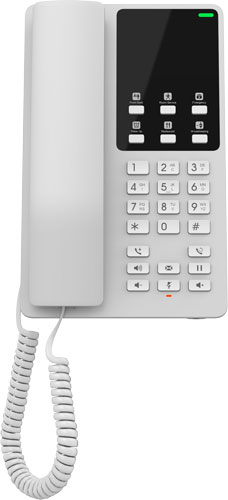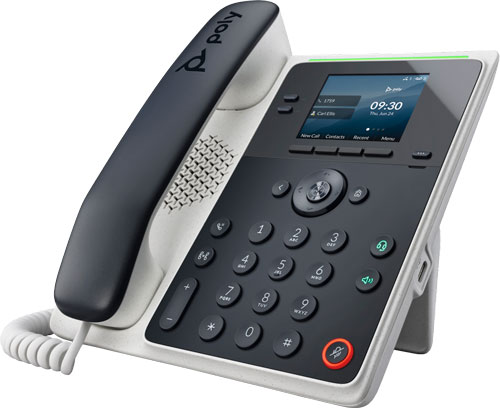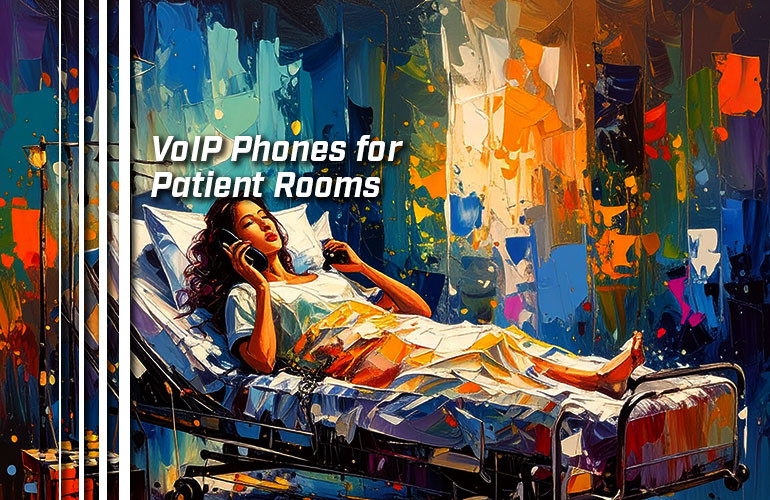VoIP phones are used across the full spectrum of communications scenarios, not just for business. You can have an everyday VoIP phone at your work desk, but there are specialized situations that call for VoIP phones with more specific feature-sets.
Take healthcare. There are numerous types of VoIP phones for healthcare facilities — phones whose features fit the needs of a scenario like a glove.
But it’s not enough to just say, “I need a phone for healthcare.” What is the specific use-case for the phone?
A VoIP phone for an emergency room isn’t necessarily the same VoIP phone used after surgery in a recovery room. It’s this second type we’re talking about today.
In this blog, we cover the key features of a patient room VoIP phone to look for:
- Simplicity
- Accessibility
- Wi-Fi
- Hygienic design
We also cover how VoIP hotel phones are an excellent option for use in patient rooms.
To be specific, we’re discussing phones that would be found in patient recovery rooms, including PACU (post-anesthesia care unit) rooms. We’re not discussing doctor’s consult room phones, hospital laboratory phones, general hospital phones, hospital lobby phones, and those types of spaces.
Patient care room phones — that’s our aim.
Let’s get into it!

VoIP Phones for Patient Rooms in Hospitals
The most important feature of a VoIP phone for patient care rooms is simplicity. When you’re recovering from surgery, you can’t be worrying about dialing a specific extension.
You want to press one button and get what you want.
While every VoIP phone offers feature keys that you can set for speed dial, not every VoIP phone is fit for patient rooms in healthcare facilities.
Simply put, you don’t want to have too many keys. A patient is not a receptionist.
Look for entry level VoIP phones with no more than 4 feature keys — which might be called line keys, multi-purpose keys, DSS keys, and many other terms. They’re the buttons on the side of the phone’s display, not the ones underneath the display. Unless it’s a touchscreen phone, which you use just like a smartphone.
Program these keys with the extensions clearly labelled for a minimum of confusion.
You’ll want the phone’s display to be easy to read. Some manufacturers have started to improve their accessibility offerings. Poly Edge E Series phones, for example, support high-contrast mode and large text size, making the display easier to read for many people.
Accessibility goes beyond the display. Edge E Series phones, to use the same example, are designed with large, tactile buttons.
Another accessibility feature to look for is a hearing aid compatible (HAC) handset. Many VoIP phones have HAC handsets now, but it’s a good idea to doublecheck before purchase.
Simplicity and accessibility — that’s a good start.
There are a few other features we recommend you look for when shopping for a VoIP phone for patient healthcare rooms.
If your healthcare facility has good Wi-Fi, getting a VoIP phone that supports Wi-Fi could be a good idea. You won’t need to worry about where the Ethernet drop is, and less cabling means less clutter. VoIP phones either have built-in Wi-Fi support or require a USB Wi-Fi dongle that plugs into the phone. Wi-Fi VoIP phones are increasingly common but are still probably the exception rather than the rule.
(A quick side note: If you do use a wired Ethernet connection, here’s something to know. Nearly all VoIP phones have two Ethernet ports — one for connecting to the LAN and one that connects from the phone to a computer. This is to let you connect the phone and computer using a single cable run. However, in a patient room, you’re unlikely to be connecting a computer via Ethernet. This second port can be turned off in the backend. Make sure you do this! Bad actors can potentially access your facility’s network if the port is active. Now back to our regularly scheduled programming.)
We don’t recommend getting a wireless phone —either a Wi-Fi phone or a DECT handset. While convenient, they are often placed in random places. You don’t want a patient in a PACU room to be looking around for where they put the phone down.
There is, however, another type of VoIP phone that’s built for simplicity. It might not immediately come to mind, but it’s perfect as a patient room phone: a hotel phone.

Using Hotel Phones in Patient Rooms
VoIP Hotel Phones are exactly what you’d think: VoIP phones with features for hotel rooms. And, when you think about it, a patient holding room is very similar to a hotel room.
In fact, the needs of a patient are actually quite similar to the needs of a hotel guest.
Both require simplicity more than anything.
There are many VoIP hotel phones. We’re going to use Grandstream GHP611 as an example. This is a slimline hotel phone with three programmable buttons and a customizable faceplate, so you can make it ultra-clear to users what each button does.
It’s about as simple a user interface that you can find for a phone — perfect for a phone in a patient care space.
By the way, if you want the same phone but with Wi-Fi support, check out Grandstream GHP611W.
A little extra advantage of hotel phones that you don’t find in a standard business VoIP phone: some of them like Grandstream GHP620 have a USB port to let guests charge their devices. GHP620 has a USB-C port dedicated to this purpose.
Because the VoIP phone in a patient room will be close to the patient’s bed, having a charger right there would be a welcome convenience.

Hygienic Phones for Patient Rooms
It’s an understatement to say that hygiene is important for patient rooms — no explanation needed.
There are VoIP phones that improve hygiene by their very construction. They do this with Microban antimicrobial technology. Microban is, in their own words (external link), “a built-in active ingredient that enables products to resist the growth of microbes such as bacteria, mold and mildew.”
Poly, in particular, have taken the lead on incorporating Microban in their phones. The Poly Edge E Series that we mentioned above not only has extensive accessibility features, but it also has Microban antimicrobial protection built into the phone.
Poly Edge E100 is a two-line VoIP phone (simple) with HAC handset (accessible) and Microban protection (hygienic). It’s a great example of the type of phone that you should be looking for when buying a VoIP phone for a patient room in a hospital.

